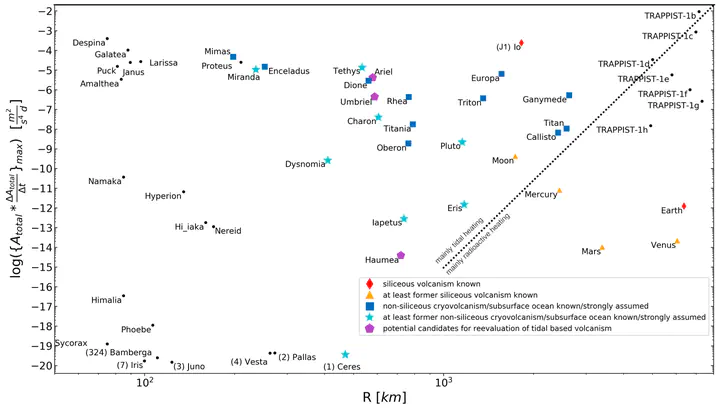Analysis of Tidal Accelerations in the Solar System and in Extrasolar Planetary Systems
 Fig. 6 - Overview over tidal accelerations in solar system and exosystem TRAPPIST-1 - © CC BY 4.0
Fig. 6 - Overview over tidal accelerations in solar system and exosystem TRAPPIST-1 - © CC BY 4.0Abstract
Volcanism powered by tidal forces inside celestial bodies can provide enough energy to keep important solvents for living systems in the liquid phase. A prerequisite to calculate such tidal interactions and consequences is depending on simulations for tidal accelerations in a multi-body system. Unfortunately, from measurements in many extrasolar planetary systems, only few physical and orbital parameters are well-known enough for investigated celestial bodies. For calculating tidal acceleration vectors under missing most orbital parameter exactly, a simulation method is developed that is only based on a few basic parameters, easily measurable even in extrasolar planetary systems. Such a method as the one presented here allows finding a relation between the tidal acceleration vectors and potential heating inside celestial objects. Using the values and results of our model approach to our solar system as a “gold standard” for feasibility allowed us to classify this heating in relation to different forms of volcanism. This “gold standard” approach gave us a classification measure for the relevance of tidal heating in other extrasolar systems with a reduced availability of exact physical parameters. We help to estimate conditions for the identification of potential candidates for further sophisticated investigations by more complex established methods such as viscoelastic multi-body theories. As a first example, we applied the procedures developed here to the extrasolar planetary system TRAPPIST-1 as an example to check our working hypothesis.
Read more in my corresponding Twitter thread:
It is nice to see something materialize in your own hands!
— Klaus Paschek (@AstroBioKlaus) February 3, 2023
Volcanos 🌋 are awesome, right?
But how about volcanos on other planets and moons? Or even on exoplanets? 🪐🌋🌕
Hooked? Then read more about their potential to make alien worlds habitable (+👇🧵): https://t.co/qPK69jC0ar pic.twitter.com/8EDyNNhf7h